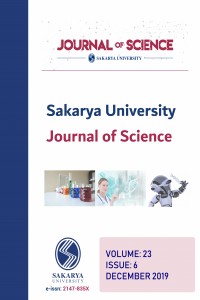Abstract
References
- C. E. Shannon, “A mathematical theory of communication”, SIGMOBILE Mob Comput Commun Rev, vol. 5, no. 1, pp. 3–55, 2001.
- A. Erdal. “Channel polarization: A method for constructing capacity-achieving codes for symmetric binary-input memoryless channels”, IEEE Transactions on Information Theory, vol. 55 no. 7, pp. 3051-73, 2009.
- K. Niu, K. Chen , J. Lin, Q. T. Zhang, “Polar codes: Primary concepts and practical decoding algorithms”, IEEE Communications magazine, vol. 52, no. 7, pp. 192-203, 2014.
- D. Marwan and Ö. Sıtkı, “Polar Codes Applications for 5G Systems”, Erciyes University, Journal of Institute Of Science and Technology, vol. 34, no. 3, 2018.
- R. W. Chang, “Synthesis of band-limited orthogonal signals for multichannel data transmission”, Bell Syst. Tech. J., vol. 45, pp. 1775-1796, 1966.
- S. B. Weinstein and P. M. Ebert, “Data transmission by frequency-division multiplexing using the discrete Fourier transform,” IEEE Trans. on Comm., vol.COM-19, pp. 628-634, 1971.
- L. J. Cimini, Jr., “Analysis and simulation of a digital mobile channel using orthogonal frequency division multiplexing,” IEEE Trans. on Comm., vol. 33, pp. 665-765, 1985.
- M. Russell and G. L. Stüber,”Interchannel interference analysis of OFDM in a mobile environment,” in Proc. VTC’95, 1995, pp. 820-824.
- Y. G. Li and L. J. Cimini, Jr., “Bounds on the interchannel interference of OFDM in time-varying impairments communications,” IEEE Trans. on Comm., vol. 49, pp. 401-404, 2001.
- X. Zhang, M. Jia, L Chen, J. Ma, J. Qiu, “Filtered-OFDM-enabler for flexible waveform in the 5th generation cellular networks”. InGlobal Communications Conference (GLOBECOM) IEEE, vol. 6, pp. 1-6, 2015.
- Altera University Program “ 5G : The 1st 5G Algorithm Innovation Competition F - OFDM ” , Presentation , May 21 , 2016 .
- Ettus Research, http://home.ettus.com/ [Accessed Date: 25 Nov. 2018].
- National Instruments, USRP-2901 Block Diagram, http://www.ni.com/documentation/en/usrp-software-defined-radio-device/latest/usrp-2901/block-diagram/ [Accessed Date: 25 Nov. 2018].
Abstract
Long Term Evolution
(LTE) is an access technique that is used in radio networks. LTE provides high
data bandwidth in transmitting data by providing flexibility against noise and
interference. Orthogonal Frequency Division Multiplexing (OFDM) technique uses
the FDM (Frequency Division Multiplexer) modulation technique to increase the
amount of carried information over the wireless network. The OFDM signal is
transmitted to the receiver at different frequencies which they are orthogonal
to each other by dividing the bandwidth of a signal into smaller sub-carriers.
Recently, the use of polar codes as a coding scheme in the new generation 5G
systems has come to the communications markets. Polar codes as a channel coding
scheme are a promising technique for the future because it is the first codes
that reach Shannon capacity limit. The cyclical prefix – OFDM (CP-OFDM), which
is used in 4G systems, performs well in many aspects, however, it has much
weakness that make the researches look for a new modulation technique to be
used in 5G systems. Filtered–OFDM (F-OFDM) is considered one solution to the
problems appeared in CP–OFDM. In this paper, the differences between CP-OFDM
and F-OFDM regarding advantages and disadvantages of each type are studied in
details. The comparison between the two modulations waveforms are done by
studying their Error Vector Magnitude (EVM) that deals with measuring the
accuracy of the received signals. Furthermore, the comparison between the two
modulations waveforms with polar codes in the USRP B210 radio are applied to
make our work more practical.
Keywords
References
- C. E. Shannon, “A mathematical theory of communication”, SIGMOBILE Mob Comput Commun Rev, vol. 5, no. 1, pp. 3–55, 2001.
- A. Erdal. “Channel polarization: A method for constructing capacity-achieving codes for symmetric binary-input memoryless channels”, IEEE Transactions on Information Theory, vol. 55 no. 7, pp. 3051-73, 2009.
- K. Niu, K. Chen , J. Lin, Q. T. Zhang, “Polar codes: Primary concepts and practical decoding algorithms”, IEEE Communications magazine, vol. 52, no. 7, pp. 192-203, 2014.
- D. Marwan and Ö. Sıtkı, “Polar Codes Applications for 5G Systems”, Erciyes University, Journal of Institute Of Science and Technology, vol. 34, no. 3, 2018.
- R. W. Chang, “Synthesis of band-limited orthogonal signals for multichannel data transmission”, Bell Syst. Tech. J., vol. 45, pp. 1775-1796, 1966.
- S. B. Weinstein and P. M. Ebert, “Data transmission by frequency-division multiplexing using the discrete Fourier transform,” IEEE Trans. on Comm., vol.COM-19, pp. 628-634, 1971.
- L. J. Cimini, Jr., “Analysis and simulation of a digital mobile channel using orthogonal frequency division multiplexing,” IEEE Trans. on Comm., vol. 33, pp. 665-765, 1985.
- M. Russell and G. L. Stüber,”Interchannel interference analysis of OFDM in a mobile environment,” in Proc. VTC’95, 1995, pp. 820-824.
- Y. G. Li and L. J. Cimini, Jr., “Bounds on the interchannel interference of OFDM in time-varying impairments communications,” IEEE Trans. on Comm., vol. 49, pp. 401-404, 2001.
- X. Zhang, M. Jia, L Chen, J. Ma, J. Qiu, “Filtered-OFDM-enabler for flexible waveform in the 5th generation cellular networks”. InGlobal Communications Conference (GLOBECOM) IEEE, vol. 6, pp. 1-6, 2015.
- Altera University Program “ 5G : The 1st 5G Algorithm Innovation Competition F - OFDM ” , Presentation , May 21 , 2016 .
- Ettus Research, http://home.ettus.com/ [Accessed Date: 25 Nov. 2018].
- National Instruments, USRP-2901 Block Diagram, http://www.ni.com/documentation/en/usrp-software-defined-radio-device/latest/usrp-2901/block-diagram/ [Accessed Date: 25 Nov. 2018].
Details
| Primary Language | English |
|---|---|
| Subjects | Electrical Engineering |
| Journal Section | Research Articles |
| Authors | |
| Publication Date | December 1, 2019 |
| Submission Date | March 6, 2019 |
| Acceptance Date | July 16, 2019 |
| Published in Issue | Year 2019 Volume: 23 Issue: 6 |
Cite
This work is licensed under a Creative Commons Attribution-NonCommercial 4.0 International License.


